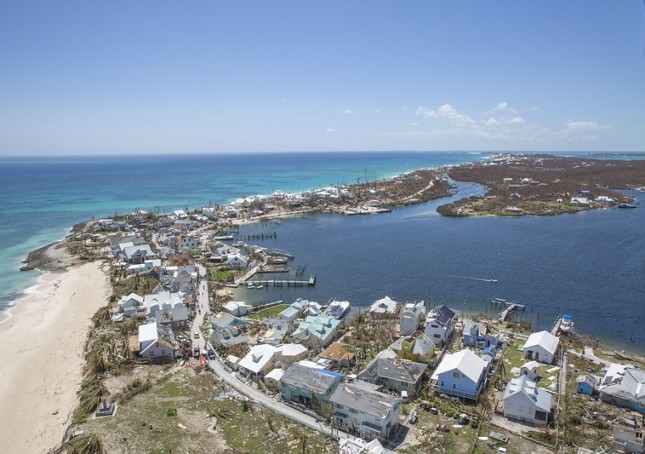The Wilson Center is partnering with the National Oceanic and Atmospheric Administration and the University Corporation for Atmospheric Research to develop a framework to improve predictive capabilities for security risks posed by extreme weather events. Our “Foresight for Action” series highlights case studies used to develop the framework.
For two weeks, Hurricane Dorian, one of
the strongest hurricanes to make landfall in the Pacific, decimated large swaths of the Caribbean displacing
70,000 people and killing at least 50. Natural disasters like Hurricane Dorian in the Caribbean have only been worsening over the last decade, a trend often attributed to warming oceanic and atmospheric temperatures.
Home to 43 million people and more sea than land, the very geography of the Caribbean Islands makes them incredibly vulnerable to hurricanes and droughts. In concert with a lack of structured regional cooperation, these natural disruptions help destabilize governments, which, in turn, makes these islands vulnerable to illicit activities and increased impacts from immigration and migration.
Ecosystem Vulnerabilities: Hurricanes and Droughts
Hurricanes Irma and Maria (2017) incurred $265 billion in damages and showcased the danger
of the rapid intensification cycles that are becoming more common. Maria was the fourth storm that year to undergo
rapid intensification. In just 54 hours, it developed from a tropical depression to a Category 5 storm. If Hurricanes Dorian, Irma, and Maria are any indicator, such storms, and the devastation they leave behind will likely only get worse. And the Caribbean sits right in the path of destruction.
In addition to the threat from hurricanes,
droughts are becoming more intense and frequent across the Caribbean, exacerbated
by El Niño events. A particularly severe drought from 2013 to 2016 required
1.2 million people to ration water, put
2 million people in danger of food insecurity, and resulted in the loss of
over $14 million in agriculture during the 2015 season.
Poor construction fails to minimize the damage caused by natural hazards. Many buildings were not built to code and therefore will be easily destroyed by extreme weather events. In fact, much Caribbean infrastructure was not
designed to withstand the increase in population or storm intensity. In times of drought, water infrastructure that is unable to store water effectively leads to agricultural shortages impacting food security and trade revenue.
The populations with the least means are the most vulnerable to the effects of natural hazards because they are the
least likely to be able evacuate and resettle. They are also most likely to be living in or near
dilapidated and unsafe infrastructure, leading to higher death tolls.
Natural disasters severely impact public health, creating new healthcare risks and destroying existing infrastructure. In the wake of Hurricane Maria, most pregnant women were left
without proper care for months. Water contamination from flooding can
lead to disease outbreaks and mold, while more standing water results in
an increase of disease-carrying mosquitos.
The Caribbean is
highly reliant on tourism which employs more than 2 million people. As a source of income, tourism is highly susceptible to hurricanes and droughts given that it simply disappears if infrastructure is unable to cope with large storms or rebound quickly. In the case of droughts, tourism requires much more water than residents.

Transnational Trends: Migration and Immigration
Research from the University of Michigan points out that hurricanes in the Caribbean between 1980 and 2004 correlated closely with
subsequent upticks in migration to the United States, a pattern that will likely repeat. In 2017,
22 percent of the Caribbean population lived abroad and accounted for
approximately 10 percent of all immigrants in the United States.
Emigrants to the Caribbean are increasing due to the current Venezuelan refugee crisis. While the Caribbean has taken in a smaller number of migrants overall,
they have the most refugees relative to their population,
about 110,500 as of June 2019, putting increased stress on weak governments and inadequate infrastructure.
As a result of consistent government weakness in response to natural disasters, there are large portions of unpatrolled Caribbean coastline. This provides opportunities for drug, human, and other illicit materials traffickers to operate unencumbered. The Caribbean has thus become one of the
main drug routes from Central America to Europe.
Political Instability: Weak Governance
Because the Caribbean region is made up of many small developing islands, largely united under Caribbean Community (CARICOM), events affecting one island reverberate through the others. In order to combat the effects of natural disasters in their region, Caribbean states created the
Caribbean Catastrophe Risk Insurance Facility (CCRIF). However, because these hazards are so common, and the Caribbean has no federal government to rely on, the CCRIF focuses on
preset, short-term payouts.
Within each island country, systems for relief and emergency preparedness vary widely in
size and approach and largely rely on existing policy structures to be effective. Regional structures are opt-in, which means that some nations are
not part of the efforts undertaken by the underfunded Caribbean Disaster Management Agency (CDEMA).
Underfunding, understaffing, and lack of international coordination means that response and recovery after a disaster may become confused and complicated without direction and a set timeframe for completion. This often means that recovery takes far longer than expected. For example, as the 2018 and 2019 storm seasons approached, disaster relief and response groups
were still trying to respond to the devastation of the 2017 cycle in Puerto Rico.
Caribbean economies are particularly vulnerable to disaster impacts because they are
small, easily destroyed, and difficult to rebuild. For instance, in Puerto Rico, the effects of Hurricane Maria were projected to lower incomes by 21 percent over 15 years, a cumulative lost economic output of $180 billion.
Just reaching the pre-storm status quo economy would take 26 years.
Improving Predictive Capabilities and Early Action
The Caribbean and its partners need to be able to cover short-term risks while planning and preparing for the long-term. Because sudden disruptive events burden the whole region, emergency response systems must be regional and cooperative with a standard hard deadline to conclude recovery efforts within two seasons of the event.
Cooperative recovery efforts will require a better understanding of how small island nations can dismantle sovereignty barriers and develop a framework for coordinated response and a resilience agenda. This framework should contain an understanding and structure for U.S. cooperation, with a complementary framework developed on the part of the U.S.
In the context of well-developed frameworks,
preparatory and resilient steps can and must be taken to create a buffer in the Caribbean against future disruptive events. Better preparation can be made with advances in high performance computing creating more effective models. Additionally, leveraging U.S. military and NOAA weather research in the region can help with predictive efforts for both hurricanes and droughts.
Resiliency can be developed as Caribbean economies are diversified with less dependence on tourism and Chinese investments. Additionally, strengthening local governance will ensure that steps are being taken to improve risk-based management of
climate-sensitive sectors and infrastructure, including insuring coastal infrastructure.
If steps are taken now to improve inter-island cooperation, preparation, and resilience, the Caribbean may be able to weather the coming storms and droughts with greater ease.
Sources: Brookings, Cayman Compass, Center for Strategic and International Studies, Circle of Blue, Climate Central, Climate.gov, CNN, Cornell Chronicle, Economist, Food and Agriculture Organization of the United Nations, Foreign Affairs, Green Hotelier, Human Rights Watch, Inside Climate News, Mel & Enid Zuckerman College of Public Health, Migration Policy Institute, National Weather Service, NOAA, Open Diplomacy, The GSMA, The New York Times, The World Bank, United Nations High Commissioner for Refugees, U.S. Global Change Research Program, USA Today.
Photo Credit: Abaco Island and Marsh Harbour Bahamas, Sept. 5, 2019. Photo by Kris Grogan, courtesy of U.S. Customs and Border Patrol.


 A Publication of the Stimson Center.
A Publication of the Stimson Center.








